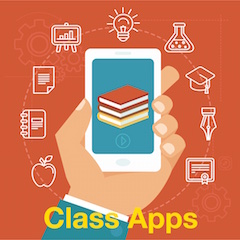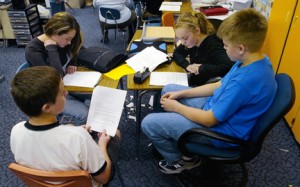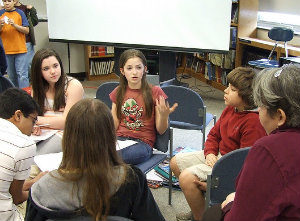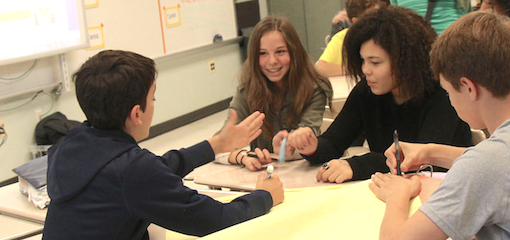Peer Power: Get More from Group Work
A MiddleWeb Blog
 When trying to organize my students into successful groups and teams, I often feel like I’m experimenting with an incomplete cookie recipe.
When trying to organize my students into successful groups and teams, I often feel like I’m experimenting with an incomplete cookie recipe.
It’s as though I have all the key ingredients—and a basic idea of what I want it to look like in the end—but I don’t know quite how to put it all together.
It can be tricky to determine just the right group size, who should be placed together, and what each group member should be asked to do.
Should I allow students to self-select into groups, or should I arrange them by skills and/or backgrounds? Should the groups be completely random?
As a teacher, I am fully aware that not all of my students succeed in groups or even prefer to work with others. But the truth is that—in the classroom and the rest of the world—we all encounter tasks that require us to cooperate, converse, and collaboratively solve problems.
Don’t get me wrong. Not every assignment can (or should) be collaborative, cooperative or team-based. Merely placing a bunch of kids around a table to complete a worksheet isn’t likely to be productive. Nor does forcing students to work in pairs on something better suited for individual completion, such as making corrections or decoding (Hattie, 2009).
Over the years, I have learned that student collaboration tends to be more effective in reading tasks than in math and is most powerful after students have enough surface knowledge to be involved in shared learning and discussion with their peers—particularly in a very structured way (Hattie, 2012).
Looking over the entire learning landscape, research indicates that most of our students are likely to learn more when they work together than when they are working alone (Kyndt et al., 2013).
Preparing Kids to Collaborate
Successful student collaboration depends on a number of things…like preparation. Teachers need to start by determining whether or not a collaborative learning task will help students reach learning goals and develop a deeper understanding of what has been taught. Teachers must also pay careful attention to how groups are formed and develop a plan to help monitor and evaluate students.

Students need enough work time during the school day as well plus good suggestions and technology tools that make it possible for them to collaborate outside of class. Above all, students need structure, scaffolding and specific, descriptive feedback as they work to accomplish their task.
Getting the Right Groups
It is amazing how a certain ‘mixture’ of kids or the size of a team can impact its ability to be successful. The key is for teachers to be flexible and strategic as they make decisions about the size, makeup, and expectations for groups.
Generally speaking, smaller collaborations are better. Research shows that the larger groups are, the more likely each individual is to feel that their individual contribution doesn’t matter (McWhaw, Schnackenberg, Sclater, & Abrami, 2003). Big groups can also result in lower external and internal motivation and make easier for kids to ‘hide out’ or over-rely on the efforts of others.
But it is equally important to help students understand how cooperative groups should work. I really appreciated Dean & Marzano’s (2013) tips for student collaborative activities:
- Establish a classroom culture that supports cooperative learning by clearly articulating expectations, norms, and parameters.
- Teach and model the structures, processes, and social skills that students will use in their groups.
- Work to provide groups (and individual members) with added instruction, practice, and feedback.
- Use cooperative learning tasks that are well-structured with clearly defined goals for learning, roles, responsibilities, and accountability for each group member.
Tech Tools for Group-making
When it comes to organizing student groups, several technology tools exist to help speed up the process.
♦ One of my favorite, no-frills tools for creating groups is Random Group Creator. Teachers need only to type or upload a class list, then select the ‘mode’ of group formation (based either on a set number of groups or a maximum group size). Random Team Generator allows teachers to enter a list of names, pick the number of teams you want, and then use the generator to assign students randomly to teams. It even picks cute little names for each team based on numbers, animals, colors or planets.
For more frills, search in your favorite app store for “random group/team generator.” Features to look for include the ability to randomize by total groups or by maximum persons and the option to create ‘diverse’ groups or organize them based on gender, performance level, or ethnicity.
♦ Alice Keeler has a tutorial on how to automatically make groups using Google Sheets. Her template allows you to copy and paste your roster of students and have them randomly divided up into groups. Each student is assigned a random number. The list is then sorted by random number and students are assigned to a group. Tweaking is up to you.
Creating Opportunities to Collaborate
Though it often seems easier to work alone, there are two certainties that face each of our students. The first is that the real world regularly requires us to work with others. The second: it’s not always easy to do so.

There will be issues. Helping students to experience team-based success isn’t easy. Nor does it happen by accident. Whether it’s a collaborative, cooperative, or team-based task we have designed for our students, it’s up to us to find just the right mixture of learning goal, task, structure, and group size.
Ultimately, effective collaboration is something that teachers create by applying their own insight and experience.
References
Dean, C. B., & Marzano, R. J. (2013). Classroom instruction that works: Research-based strategies for increasing student achievement. Boston, Mass: Pearson Education.
Hattie, J. (2009). Visible learning: A synthesis of over 800 meta-analyses relating to achievement. London: Routledge.
Hattie, J. (2012). Visible learning for teachers: Maximizing impact on learning. Oxon: Routledge.
Kyndt, E., Raes, E., Lismont, B., Timmers, F., Cascallar, E., & Dochy, F. (2013). Review: A meta-analysis of the effects of face-to-face cooperative learning. Do recent studies falsify or verify earlier findings?. Educational Research Review, 10133-149. doi:10.1016/j.edurev.2013.02.002
Ashman, A., & Gillies, R. (Eds.). (2003). Cooperative learning: The social and intellectual outcomes of learning in groups. Routledge.





























